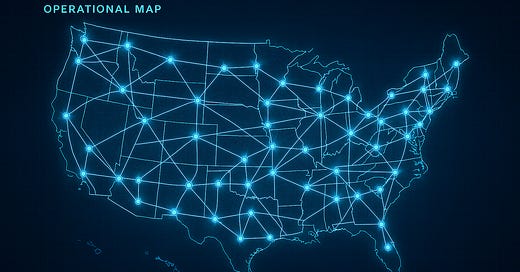The Genome in Fifty Pieces
In a world where biology powers geopolitics, one analyst must help rewire the United States into a resilient, decentralized biomanufacturing force.
“State Fourteen is down. Switching contingency feedstock to Vermont and Utah.”
I blinked twice to clear the haptic overlay from my vision, watching as a pale blue arc lit up across the Appalachian corridor. Fermentation input lines were rerouting in real-time, wheat husk to algal base to sugarcane waste, just another day in the life of a national biotech grid under siege.
It wasn’t a cyberattack. It wasn’t sabotage. It was something worse.
It was trade policy.
My name is Rafi Ahmad. I’m a senior systems analyst at the National Biotechnology Coordination Office - NBCO, for short. Think of us as the nervous system for America’s distributed biomanufacturing infrastructure. Except instead of neurons, we manage gene circuits, industrial microbes, policy triggers, and geopolitical risk vectors.
And this morning, Brazil just locked our East Coast feedstock out of their carbon-negative fermentation markets.
This is a science fiction story inspired by Chapter 1 of the final report from the National Security Commission on Emerging Biotechnology. This may be fiction, but it’s my way of exploring the world around me. Lets make this happen.
You’d think by now, we’d have learned not to put all our biomass in one basket.
But the truth is, nobody expected Brazil to become a fermentation superpower. While we were focused on China’s synthetic genome factories and Russia’s dark AI-bio labs, Brazil invested in global fermentation diplomacy. They offered low-cost licensing to Southeast Asia, built modular distillation hubs across sub-Saharan Africa, and weaponized climate guilt into the world’s first bio-carbon credit exchange. Now they control 46% of the global agricultural feedstock-to-bioreactor supply chain.
Meanwhile, India owns scale.
It started with vaccines, low-cost, high-volume, near-infinite redundancy. But the Serum Institute era was just Phase One. India went full-stack: enzymes, CRISPR scaffolds, precision fermentation arrays, biologic drug manufacturing, even bioelectronics. They did it the way only India could: dense talent, relentless iteration, and a diaspora-fueled biotech export strategy so sophisticated it made Silicon Valley look quaint.
And then there’s Denmark. Ah, the polite empire.
Danes don’t shout. They manufacture elegance. Their biotech footprint is surgical: they dominate global markets in insulin, monoclonals, biosimilars, and next-gen fermentation chassis. With Novo Nordisk, Genmab, and the Copenhagen Consensus Forum aligning biotech R&D to both humanitarian and strategic ends, they don’t need a Pentagon. They just need IP.
And that brings us to today.
Because for the first time in a century, the United States no longer holds the commanding heights of a transformative technology. Not in cost. Not in speed. Not even in reliability.
And that’s why I sit here every day at NBCO headquarters, a retooled DARPA compound in Arlington, feeding forecasts into the National Security Council’s Technoeconomic Risk Tableau.
Every morning begins with the same question:
“Which part of the American genome is most vulnerable today?”
Right now, it’s insulin precursors in the Midwest, fermentation saltbases in the Carolinas, and microbial pigment exports in California.
Next week? Could be anything.
We built the Coordination Gene, the interagency intelligence web that models our national biotech posture. But a model’s only as good as its inputs. And our inputs change by the hour. Bioreactors stall. Feedstock contracts evaporate. Diplomats lose handshakes. Senators invent new acronyms.
The truth is: we’re building the new arsenal of democracy out of bugs, barrels, and bandwidth. But it’s fragile. And it’s under pressure.
So, we made a plan.
We call it “Fifty BioStates.”
The idea is simple, brutal, and beautiful: every state gets at least one federally-supported biomanufacturing node. Not just research centers. Production. Fermentation. Synthetic biology. Downstream processing. Waste recovery. Last-mile distribution.
Each node gets paired with regional academic hubs and industrial off-takers. They operate semi-autonomously, connected by shared digital twins, mirrored bioreactor controls, and AI-driven microbial inventory. If Iowa goes down, Oregon picks up the slack. If supply chains choke on coastal ports, inland distribution takes over.
It’s resilience not as a backup but as a design principle.
And every week, the nodes get smarter. We send pattern recognition tasks to distributed networks of farm sensors and wastewater bioassays. The result? A real-time map of America’s biological throughput capacity. As fluid and living as the country itself.
But let me be honest: the geopolitical game is getting nastier.
Just last month, India filed an IP challenge at the WTO against our modular protein synthesis platforms. Denmark quietly blocked a bulk enzyme shipment from crossing into Quebec, our largest synthetic biologics partner. Brazil started offering biotrade deals that exclude any U.S.-aligned economies.
And China? China watches. Patient. Systemic. Coordinating its biotech influence across ASEAN, the African Union, and the Shanghai Bio Partnership.
If biotech is the next oil, we’re in the middle of a fermentation Cold War.
And that’s exactly why we built the Fifty BioStates.
Because this time, we won’t be caught flat-footed. Not by a single point of failure. Not by a coastal disruption. Not by diplomatic blackmail. Our strategy is simple: redundancy, modularity, velocity.
Some nights, I look at the map, the pulsing overlay of fifty states, each with its own microbiome, its own production profile, its own risks and opportunities. The system breathes like a lung. Expanding. Contracting. Resilient.
And I remember what Aria Juno, the first NBCO Director, said when she lobbied for this office:
“The future of national power is no longer who holds the most weapons, but who can grow what, where, and how fast.”
Now, she’s the President’s Science Advisor.
And me?
I’m just the guy watching the genome flicker, in fifty pieces, across a country trying to stitch itself into something stronger than it’s ever been.
Not a superpower of dominance.
A superpower of coordination.




